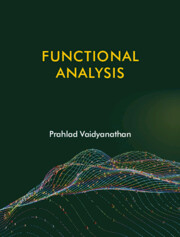9 - Measure and Integration
Published online by Cambridge University Press: 31 January 2025
Summary
9.1 Positive Linear Functionals on C*-Algebras
In our quest to understand operators on a Hilbert space, we now take a detour. The purpose of this chapter is to prove a deep relationship between measures and linear functionals. The main theoremin this context is the Riesz–Markov–Kakutani Theorem, one of the most important theorems in modern analysis (this theorem is also referred to as the Riesz Representation Theorem, but we choose to use the longer name so as to prevent any confusion with Theorem 3.2.2). We will then use this result to identify the dual space of C(X), the space of continuous functions on a compact metric space X.
We begin by studying positivity in the context of C*-algebras; a notion that was baked-in to the theory by the founding fathers of the subject.
9.1.1 DEFINITION An element a in a C*-algebra A is said to be positive if it is self-adjoint and σ(a) ᑕ [0,∞). Wewrite A+ for the set of all positive elements in A and write a ≥ 0 if a ∊ A+.
The next lemma tells us where to look for positive elements and allows us to construct some simple examples.
9.1.2 LEMMA If a ∊ A is positive, then there exists b ∊ A such that b*b = a.
Proof. Suppose first that A is unital and let f ⟼ f (a) denote the continuous functional calculus. Since σ(a) ᑕ [0,∞), g(t) := t1/2 defines a continuous function on σ(a) and b := g(a) satisfies the required condition.
If A is non-unital, then we may apply the same argument in the unitalization Au. Since g(0) = 0, Remark 8.5.4 tells us that b ∊ A.
- Type
- Chapter
- Information
- Functional Analysis , pp. 397 - 444Publisher: Cambridge University PressPrint publication year: 2023

